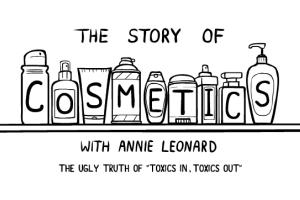Did you know that most first aid creams contain methylparabens, a.k.a. known carcinogens? The same holds true for a lot of the seemingly innocuous personal care products you buy in your local drug store. Makes Rite Aid seem more like Frite Aid.
Once you bring these products into your home, says The Story of Stuff author Annie Leonard, you turn your bathroom into “a minefield of toxics.”
Leonard details the dangers of these take home toxins in her latest Story of Stuff video. It’s worth watching, and sending on to anyone you’ve ever cared about:
“The FDA doesn’t assess the safety of personal care products,” notes Leonard. In fact, less than 20 percent of the chemicals in the products we trust and use everyday has been assessed for safety. Legislation on decision-making for ingredient safety in the cosmetic industry has not been updated since 1938. But new legislation may help change that.
Yesterday, Reps. Jan Schakowsky (D-Ill.), Ed Markey (D-Mass.), and Tammy Baldwin (D-Wisc.), introduced the Safe Cosmetics Act of 2010. This legislation would give the Food and Drug Administration authority to insure that personal care products are free of harmful, toxic ingredients.
According to the press release from the Campaign for Safe Cosmetics, this legislation would:
- Phase out ingredients linked to cancer, birth defects, and developmental harm
- Create a health-based safety standard that includes protections for children, the elderly, workers, and other vulnerable populations
- Close labeling loopholes by requiring full ingredient disclosure, including the constituent ingredients of fragrance and salon products, on product labels and company websites
- Give workers access to information about unsafe chemicals in personal care products
- Require data sharing to avoid duplicative testing and encourage the development of alternatives to animal testing
- Provide adequate funding the FDA Office of Cosmetics and Colors so it has the resources it needs to provide effective oversight of the cosmetics industry
- Level the playing field so small businesses can compete fairly
If you’re concerned about lead in your lipstick or carcinogens in your first aid cream, support the Safe Cosmetics Act 2010!



